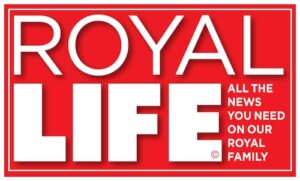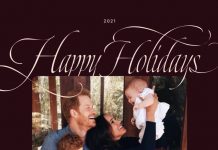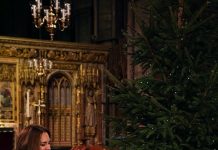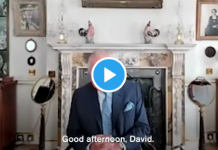Over two billion people watched in hushed anticipation as William placed the ring on his bride’s finger in Westminster Abbey. For one short moment it looked as if it wouldn’t fit, but the Prince kept his cool as he managed to put the simple gold band in place. It was surely the only slightly tense moment of an otherwise impressively orchestrated ceremony that proved to be one of the most awesomely beautiful Royal weddings ever staged. The bride-to-be had arrived at Westminster Abbey at 11am to a cacophony of church bells and trumpets. Inside were gathered 1,900 guests anxiously awaiting her and all excited to see ‘the dress’ that she had so magnificently kept secret from the world. None more so that Prince William, of course. Her doting father took her left hand and her sister Pippa carried her train as Kate began her procession along the red carpet that started outside the ancient building and led inside. This took her round the south side of the poppy-lined Grave of the Unknown Warrior – the only gravestone in the abbey over which it is not permitted to walk. They were greeted by Dr. John Hall, the Dean of Westminster and there was a brief pause as final adjustments were made to the Alexander McQueen dress before the procession began. This was, of course the first ceremony ever to be broadcast worldwide in high definition, and the press took full advantage of this. A number of newspapers employed lip-readers to see if they could decipher some comments from the Royals, and it was reported that when Kate and her father arrived at the altar Prince William said to his future wife “you look lovely, you look beautiful” then he cracked a joke to his father-in-law saying: “We’re supposed to have just a small family affair!”
Kate’s bridesmaids (the youngest being Eliza Lopes and Grace van Cutsem – both just three-years-old) and page boys were all assembled beneath the beautiful 18th-century stained glass of the West Window of the Abbey as the bride walked up the aisle to the sound of ‘I Was Glad,’ written in 1902 by Sir Hubert Parry and traditionally sung at the coronation of British monarchs. The Ceremony began with the hymn, ‘Guide Me O Thou Great Redeemer,’ a traditional Christian hymn which, poignantly, was the last sung at Princess Diana’s funeral. Then, Kate began her walk to the altar past delighted guests including Prime Minister David Cameron and other senior politicians. Arriving at the Lantern, she finally joined William at the Sacrarium steps. He was looking very dashing in his red Irish Guards uniform and the couple exchanged loving looks. On the South side of the church were William’s grandparents the Queen and the Duke of Edinburgh, his father the Prince of Wales and stepmother the Duchess of Cornwall, and other members of the Royal Family. On the north side of what is known as the transept were the Middletons, the Spencers and many of William and Kate’s close friends.
The choirs of the Abbey and Her Majesty’s Chapel Royal, St James’s led the congregation beautifully. Then the Dean started the service in the traditional manner with those well known words: “Dearly beloved, we are gathered here in the sight of God and in the face of this congregation, to join together this man and this woman in holy matrimony… If any man can shew any just cause why they may not lawfully be joined together, let him now speak, or else hereafter forever hold his peace.” The Archbishop of Canterbury, Dr. Rowan Williams then took over the solemnisation of the marriage and continued by asking the bride and groom: “..if either of you know any impediment, why ye may not be lawfully joined together in matrimony, ye do now confess it.” For some strange reason this is always a bit of a tense moment, though of course no reasons were forthcoming. Asked if he would “love her, comfort her, honour her and keep her”, it was William’s first opportunity to speak and he replied in a clear and firm voice, “I will.” His bride had a softer tone as she responded “I will” when she was asked the same question.
It was already public knowledge that Kate had chosen to take the modern version of marriage vow that does not include the commitment to ‘obey’ the husband, according to the prayer book of the Church of England. As part of the revised version of the prayer book, the bride in Church of England weddings is asked to take one of two vows: 1. ‘(Wilt) thou have this man to thy wedded husband, to live together after God’s ordinance in the holy estate of Matrimony? Wilt thou obey him, and serve him, love, honour, and keep him in sickness and in health; and, forsaking all other, keep thee only unto him, so long as ye both shall live?’ 2. “(Wilt) thou have this man to thy wedded husband, to live together according to God’s law in the holy estate of Matrimony? Wilt thou love him, comfort him, honour and keep him, in sickness and in health? And, forsaking all other, keep thee only unto him, so, long as ye both shall live?” Like Princess Diana before her, Kate chose the second version. At exactly 11.20 am, William placed the ring on Kate’s finger. The Archbishop addressed the congregation with the words: “Forasmuch as William and Catherine have consented together in holy wedlock, and have witnessed the same before God and this company, and thereto have given and pledged their troth either to other, and have declared the same by giving and receiving of a ring, and by joining of hands; I pronounce that they be man and wife together. In the name of the Father, and of the Son, and of the Holy Ghost. Amen.”
The congregation then sang the well-known hymn, Love Divine, by Charles Wesley, and James Middleton, Kate’s brother, stepped up to deliver the Lesson. His reading from Romans, chapter 12, verses 1, 2, and 9-18 included the words, “Let love be genuine; hate what is evil, hold fast to what is good; love one another with mutual affection; outdo one another in showing honour.” He delivered it in a strong, confident fashion. Next came perhaps the most beautiful and moving piece of music of the day, a sublime anthem specially commissioned for the service by the Dean and Chapter of Westminster. Modern day composer John Rutter’s wonderful music was beautifully performed and its message was simple, “put thou thy trust in the Lord.” Then it was the turn of the Bishop of London, the Rt Rev Richard Chartres, to address the congregation. Calling this “a day of hope” the Bishop, who is a close friend of the groom’s family, ended his address to the congregation, saying: “I pray that all of us present and the many millions watching this ceremony and sharing in your joy today will do everything in our power to support and uphold you in your new life. And I pray that God will bless you in the way of life you have chosen, that way which is expressed in the prayer that you have composed together in preparation for this day.”
He then read a prayer penned by William and Kate: “God our Father, we thank you for our families; for the love that we share and for the joy of our marriage. In the busyness of each day keep our eyes fixed on what is real and important in life and help us to be generous with our time and love and energy. Strengthened by our union help us to serve and comfort those who suffer. We ask this in the Spirit of Jesus Christ. Amen”. After a Latin choral composition sung by the choirs and the reading of The Lord’s Prayer it was time for all to join in singing William Blake and Edward Elgar’s inspirational hymn, Jerusalem. There can’t have been anyone present who didn’t already know those immortal words: “And did those feet in ancient time walk upon England’s mountains green? And was the holy lamb of God on England’s pleasant pastures seen?”
Following the blessing of the marriage by the Dean, and the singing of The National Anthem, the married couple and their immediate family got a rare if short opportunity for some privacy as they went behind the scenes to the tiny enclosed Chapel of St Edward the Confessor behind the altar to sign the three registers required for a Royal wedding at Westminster Abbey. Two registers forming part of the Abbey collection and a further one the Chapel Royal register kept by officials at the Chapel Royal. They were joined by Prince Charles and Camilla, Michael and Carole Middleton, best man Harry and Kate’s brother James and sister Pippa.
The happy couple emerged some eleven minutes later to a rousing 30-second fanfare entitled Valiant and Brave performed by seven trumpeters and one drummer from the RAF Central Band. The piece was named in honour of the motto of the Prince’s RAF Search and Rescue No 22 Squadron. Before making their way back down the aisle the couple paused to pay their respects to the Queen. Kate gave a low curtsy, William a nodding bow. The bride and groom then walked back through the church with Harry and Pippa and their Bridesmaids and Page boys behind them, and emerged to greet the adoring crowds outside. The entire ceremony had lasted a relatively short one hour and ten minutes, but as far as history is concerned it will never be forgotten.
This Article was taken from Royal Britain’s Guide to the Royal Wedding – Part 2
– See more at: http://royalbritainmagazine.co.uk/article_single.php?id=2#sthash.tuOOyng1.dpuf










